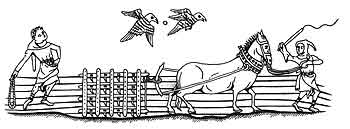Willen Employment


Medieval farming



Pictures drawn by D. Mynard, reproduced courtesy of MK Parks Trust
Willen Employment |
|||||||||||||
 |
|||||||||||||
 |
|||||||||||||
Medieval farming |
|||||||||||||
| Just like today, the farming year is marked by changes in the jobs that had to be done. Peasants hoed and harvested their own strips, but worked together on big jobs such as ploughing or hay-making. Working together was essential, a failed harvest could mean starvation for the whole village.Crop growing areas around villages were usually divided into three big fields, (see 1520 map). One field was sown with wheat in winter, the second was sown with rye, barley or oats in spring and the third would be left empty, or fallow, so it could recover its strength. | |||||||||||||
| In Autumn, the land had to be ploughed, in medieval times this was done with a team of oxen pulling a small plough which was very difficult to turn. | |||||||||||||
 |
|||||||||||||
 |
|||||||||||||
| After ploughing came harrowing, this broke up the large lumps of soil , ready for sowing the seed. | |||||||||||||
 |
The seed was scattered, or broadcast by hand. Small boys were kept busy over the next few months, scaring away crows and pigeons that would eat the seed and young corn if given a chance. Finally, the corn would be ready for harvesting. This was very hard work. Once it was finished, everyone would celebrate with a Harvest Festival.
Pictures drawn by D. Mynard, reproduced courtesy of MK Parks Trust |
||||||||||||
| Many of the medieval ridge and furrow fields were enclosed in early Tudor times and used as grazing for sheep. In Willen, enclosure of the land was not completed until the mid 1600s. The Nicolls family bankrupted themselves completing the job. Some of the fields around Willen are still used for sheep pasture even today and have not changed their shape or appearance for at least 480 years. | |||||||||||||